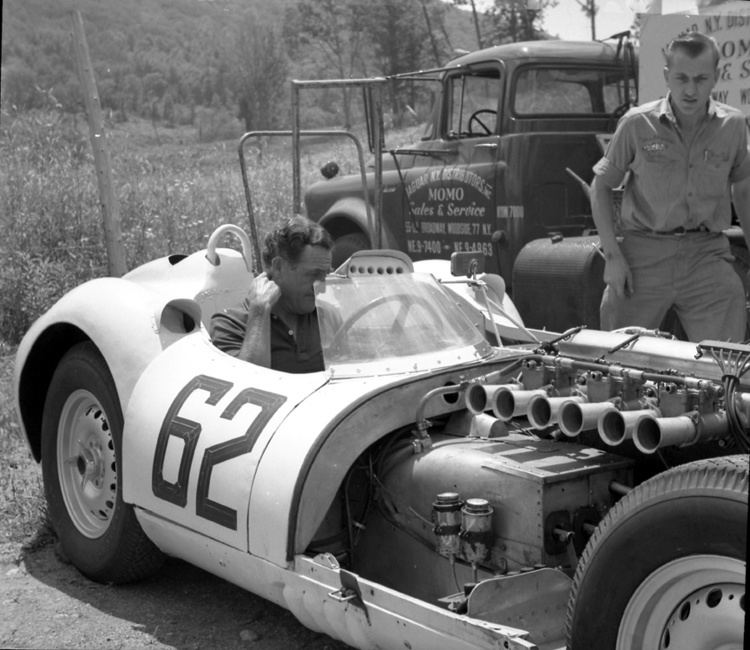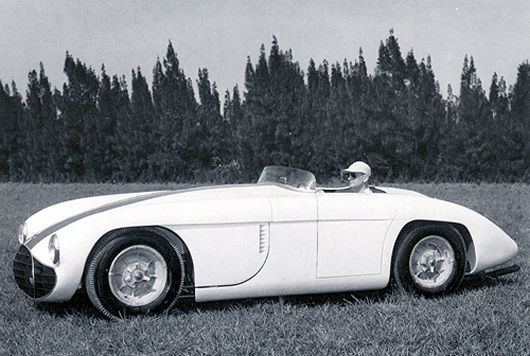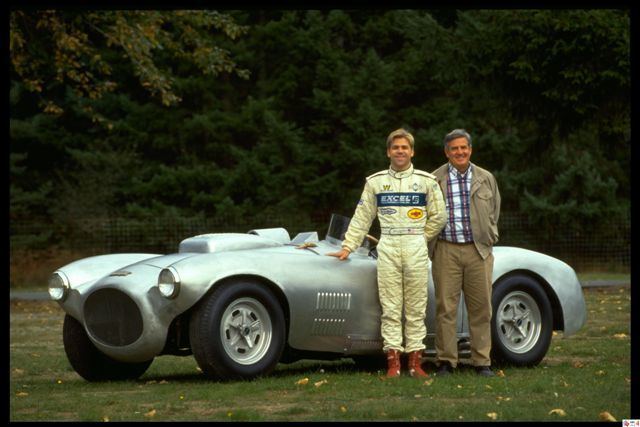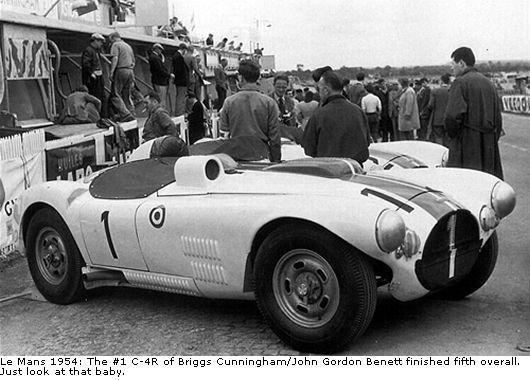Name Briggs Cunningham | Role Race car driver | |
 | ||
Died July 2, 2003, Las Vegas, Nevada, United States | ||
Rare car briggs cunningham c2r
Briggs Swift Cunningham II (January 19, 1907 – July 2, 2003) was an American entrepreneur and sportsman, who raced automobiles and yachts. Born into a wealthy family, he became a racing car constructor, driver, and team owner as well as a sports car manufacturer and automobile collector.
Contents
- Rare car briggs cunningham c2r
- Briggs cunningham auto museum sadly closed in 1987 forever
- Yachting
- Automobile manufacture and competition
- C3
- C2 R and C4 R
- C6 R
- Team successes with other marques
- Collection
- Legacy
- Drivers
- References

He skippered the first victorious 12-metre yacht Columbia in the 1958 America's Cup race, and invented the cunningham downhaul to increase the speed of racing sailboats.

He was featured on the April 26, 1954 cover of Time magazine, with three of his Cunningham racing cars. The caption reads: Road Racer Briggs Cunningham: Horsepower, Endurance, Sportsmanship. He became an early member of the Road Racing Drivers Club (RRDC), an invitation-only club formed to honor notable road racing drivers.

The October 2003 Road & Track magazine article, "Briggs Swift Cunningham—A Life Well Spent", states that "by building and sailing his own ships, and building and racing his own cars, Briggs Cunningham epitomized the definition of the American sportsman." He was inducted into the America's Cup Hall of Fame in 1993, the Motorsports Hall of Fame of America in 1997, and named to the International Motorsports Hall of Fame in 2003.

Cunningham died in Las Vegas, of complications from Alzheimer's disease, at the age of 96.

Briggs cunningham auto museum sadly closed in 1987 forever
Yachting

In 1931 Cunningham was a crew member on the Dorade when it won the Fastnet race.

In 1958 he skippered the first victorious 12-metre yacht Columbia in the first post war America's Cup race.

He invented the eponymous Cunningham commonly used to control a sailboat's luff tension and improve sail shape.
Automobile manufacture and competition
Introduced to motorsports as a youngster when his uncle took him to road races just after the first world war, Cunningham began international racing in 1930 with his college friends Miles and Samuel Collier, who in 1933 founded the Automobile Racing Club of America (renamed the Sports Car Club of America (SCCA) in 1944). He continued in competition for 36 years.
By 1940 he was building sports cars for others to race. His first race as a driver was with his Bu-Merc, a modified Buick chassis with Buick engine and Mercedes-Benz SSK body, at Watkins Glen shortly after World War Two. Some of his other hybrids involved Cadillacs, Chryslers, and Fords. Cunningham was one of the first to purchase a Ferrari Tipo 166 Corsa Spyder, which was raced along with other marques he constructed or owned.
In 1950 Briggs Cunningham entered two Cadillac cars for Le Mans, one a stock-appearing Sixty Special, the other a special-bodied sports car dubbed "Le Monstre." They finished 10th and 11th overall. On December 31, 1950 Cunningham participated in the 6-hour Sam Collier Memorial Race, the first automobile race held on the Sebring Airport race track, which was won by a Crosley HotShot. Cunningham finished 3rd in class and 17th overall in his Aston Martin DB2 Vantage LML/50/21, the first produced.
1955 was last year for the Cunningham marque of cars. The Internal Revenue Service rules of the time allowed such prototype low volume manufacturers 5 years to reach profitability before classifying the business as a non-deductible hobby.
By 1956 Team Cunningham, which also fielded other marques, was described as a dominant force in SCCA sports car racing — a distinction the team retained for the next decade. The team traveled in a caravan with tractor trailer vans that contained the automobiles, mechanics and equipment, and set up in the pits to serve every mechanical or personal need of the team. This contrasted with the typical arrival into the pits of a single race car on a trailer, and was described as "impressive" by driver Lake Underwood. The team's chief mechanic was Alfred Momo.
C3
Cunningham concentrated on competition automobiles; high-performance prototypes that he and his team built specifically for racing in the 1950s. A few, adapted for street use, were personal vehicles. In 1952, Cunningham introduced the Continental C3 road car. Production began in his West Palm Beach plant where his team of mechanics installed 331-cubic-inch Chrysler hemi V-8s in Cunningham C-2R racing chassis. These were shipped to Turin, Italy to be fitted with aluminum and steel bodies by coachbuilder Vignale, after which they were returned to the Florida plant for completion. There were 25 Continental C3s produced: 20 coupes and five convertibles. They sold for $8,000 to $12,000. Notable owners included Nelson Rockefeller and a member of the Du Pont family. In 2017, Jay Leno completed an extensive restoration on a C3. All 25 cars still exist.
C2-R and C4-R
Cunningham's announcement in 1951 of his intention to build an American contender for outright victory at the Le Mans race caused a stir on both continents. His team was already a favorite with the Le Mans fans, and the announcement demonstrated his commitment to fielding a winning team of American drivers and automobiles.
One of the cars, the Chrysler-powered Cunningham C2-R built by The B. S. Cunningham Company of West Palm Beach, Florida and driven by Phil Walters and John Fitch, finished 18th out of 60 starters. The other, driven by George Rand and Fred Wacker Jr., failed to finish.
In 1952, the C4-R of Briggs Cunningham and Bill Spear finished fourth overall at Le Mans.
A C4-R won the 1953 Sebring 12 Hours. At Le Mans, Walters and Fitch finished first in class and third overall with a C5-R, and the two other Team Cunningham cars finished seventh and tenth. They returned to take third and fifth place in 1954.
These years were to be the high point of achievement for Cunningham-built cars at Le Mans. With victory unattained, the effort was described as a "gallant failure" by American journalist Ozzie Lyons. Later in 1954, a C4-R driven by Briggs Cunningham and Sherwood Johnston finished sixth in the Reims 12 Hour sports car race, behind three Jaguars and two Ferraris.
Malcolm Sayer, designer of the Jaguar D-Type, noted after the 1954 Le Mans that the chassis frame of the C4-R had "no effective diagonal bracing. It therefore twists so much that the door cannot work if one rear wheel is jacked up", and that the bodies were designed "with no theoretical basis".
C6-R
At Le Mans in 1955 the Cunningham C6-R, fitted with an Offenhauser engine, retired from the race. Second and third gears failed, and the engine, designed for methanol fuel and insufficiently modified for the mandatory French pump gasoline, overheated. A burned exhaust valve ended the car's run.
Team successes with other marques
In addition to Cunninghams, the team raced Ferrari, Jaguar, Maserati, Corvette, O.S.C.A., Porsche, and other sports cars. One set a record in 1954 that remains unbroken: driven by Stirling Moss and Bill Lloyd, Cunningham's 1.5-liter O.S.C.A. MT4 become the smallest-engined car ever to win the Sebring 12 Hours race, and also the first to win on wire wheels. The team won at Sebring again the following year, this time with a Jaguar D-Type. In 1960 Cunningham entered a team of four cars at Le Mans: three race-modified 1960 Chevrolet Corvettes, and an E-type Jaguar driven by Dan Gurney. The No. 3 Corvette, driven by John Fitch and Bob Grossman, finished first in the GT Class and eighth overall, the first-ever class win by a Corvette at Le Mans. The model's best-ever finish there, the achievement was unsurpassed for over 40 years. In 1964 Briggs Cunningham and Lake Underwood won the 3.0 Liter Prototype class at Sebring with their jointly-owned Porsche 904 GTS, and in 1965 they won the 2-liter class and finished ninth overall, again with a 904 GTS.
Collection
Cunningham amassed a collection of automobiles that included the first Ferrari in the United States, sold to him by Luigi Chinetti, and a Bugatti Royale, one of only six made. To house the collection he opened the Cunningham Museum in Costa Mesa, California. Eventually the vehicles were sold to the son of his long-time friend Miles Collier, to be combined with the Collier Automotive Museum collection in Naples, Florida, which is now called The Revs Institute and is open to the public.
Legacy
Sebring Raceway's "Cunningham Corner" is named for Cunningham and his team.
The Cunningham C7, introduced at the 2001 Detroit International Automobile show, was the product of an enthusiast collaboration between Robert (Bob) Lutz, Lawrence (Larry) Black, and Briggs Cunningham's only son Briggs S. Cunningham III.
Cunningham Motorsports, currently running a Dodge Charger in the ARCA Racing Series as part of Penske Racing's driver development program, is jointly owned by Briggs Cunningham III and Kerry Scherer.
In 1981 Cunningham was the first American marque to be featured at the Monterey Historic Automobile Races.
Briggs Cunningham's grandson, Brian S. Cunningham, raced in Formula Three in 1994.
Drivers
Cunningham team drivers and Briggs Cunningham co-drivers included:
